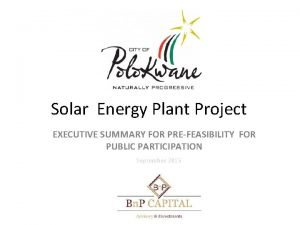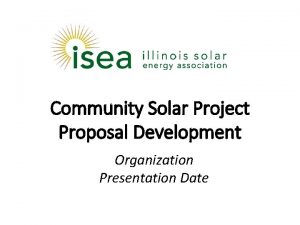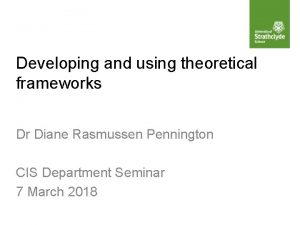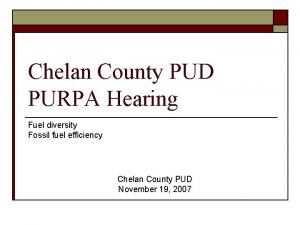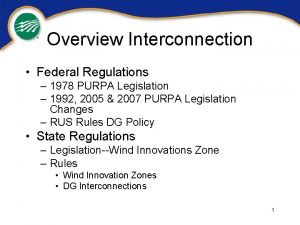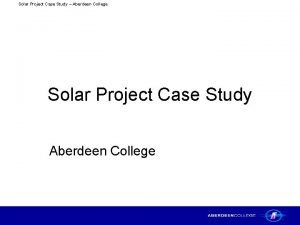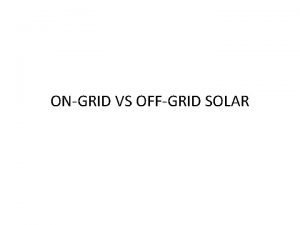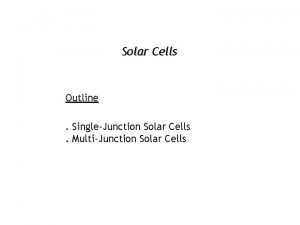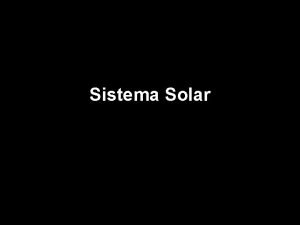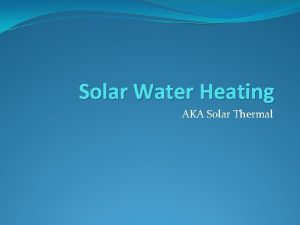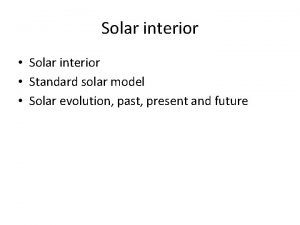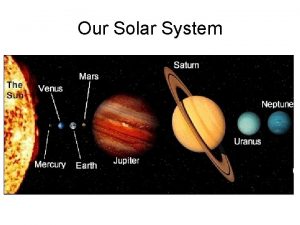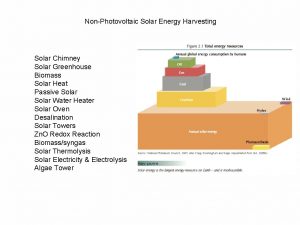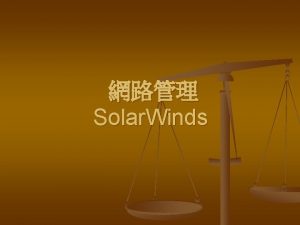Solar Project Development and PURPA May 2017 1























- Slides: 23

Solar Project Development and PURPA May – 2017 1

Utility Scale Solar Development § Missouri has begun to see development and construction of utility-scale solar projects § What is the Public Service Commissions role in shaping the development of such facilities and how have other states approached this subject? § Cypress Creek Renewables is actively developing such projects across the country in more than 14 different markets § Based on our experience we have learned that PURPA implementation is a critical role the Public Service Commission can play in guiding solar development § The comparison of policies between Missouri and North Carolina provides an excellent illustration of the power the public service commission has over the solar market. 1. 2. CONFIDENTIA L (2016). Economic impact analysis of clean energy development in North Carolina-2016 update. Research Triangle Park, NC: RTI International. 2016). Conservatives for Clean Energy 2016 Energy and Voters Poll http: //www. cleanenergyconservatives. com/2016 -poll/ SECTION TITLE | 2

TABLE OF CONTENTS I. Cypress Creek Renewables Overview II. Basics of PURPA III. Missouri vs. North Carolina CONFIDENTIA L IV. Benefits of a Vibrant QF Market V. Questions CYPRESS CREEK RENEWABLES | 3

CYPRESS CREEK RENEWABLES OVERVIEW CONFIDENTIA L CYPRESS CREEK RENEWABLES | 4

CYPRESS CREEK RENEWABLES High growth development and project financing platform, diversified across the U. S. § More than 1 GWdc completed. § Built 400 MWdc in 2016 § 5 GWdc additional 2017 and beyond pipeline t ABOUT § § DEVELOPMENT STRATEGY § § FINANCING STRATEGY § § § GROWTH TRAJECTORY CONFIDENTIA L Business model focuses on utility-scale ground mount projects primarily 2 -80 MW in capacity in multiple U. S. states. Multi-pronged development strategy: QF standard offer PPAs, bilateral PPAs, retail markets, & community solar. Invest in sponsor equity using proceeds from sales of projects, back-leverage, and operating assets cash flows. § EXPERIENCED TEAM Cypress Creek Renewables is a utility-scale solar developer and long-term owner and operator of solar projects. Monetization of tax benefits, optimization of cash flows, and debt facilitate long-term ownership of assets. Combined track record of developing or financing over 200 operational utility-scale projects throughout the U. S. In-depth development experience, solar financing expertise, and relationships enable Cypress’s multi-faceted model. Declining build costs, long-term extension of the ITC, and opening of new markets will all drive Cypress’ growth. § Multiple site origination channels, standardized approach to development, and our own customer acquisition platform offer the opportunity to achieve scale at a pace exceeding that of the market. CYPRESS CREEK RENEWABLES | 5

DEVELOPMENT STRATEGIES Multi-pronged development strategies for utility-scale solar 2 -80 MWac STANDARD OFFER QF PPAs BILATERAL QF PPAs RETAIL/COMMUNITY SOLAR § Standardized 15 -25 yr QF PPA at fixed avoided cost rates; typically capped project sized (<10 MWac) § Core markets: NC (5 MWac) and OR (3 -10 MWac) § § Pipeline size: 750+ MWdc Bilaterally negotiated QF PPAs of 10 -20 years; requires good utility relationships Strong pipeline in NC (10 yr PPA), SC (15 -20 yr PPA) Pipeline size: 1, 600+ MWdc § § § CONFIDENTIA L Directly selling power to residential customers in various regulatory environments Cypress originates customers directly, opening de-regulated markets (primarily TX and NY) Pipeline size: 1, 015+ MWdc CYPRESS CREEK RENEWABLES | 6

Basics of PURPA CONFIDENTIA L CYPRESS CREEK RENEWABLES | 7

Since becoming law in 1978 PURPA has served as an effective measure in promoting independent power producers and renewable energy PURPA, a deeply entrenched federal law, was instituted in 1978 with the goal of diversifying the country’s electric power supply base by facilitating market access for small renewable energy generators and cogeneration facilities Genesis and Purpose § The Public Utilities Regulatory Policy Act (PURPA) was passed as part of the National Energy Act in 1978 in response to the 1973 oil crisis § As such, PURPA is primarily designed to encourage reduced dependence on foreign oil imports through 1: 1. Diversification of the electric power industry via development of alternative generation sources 2. Promotion of efficiency related to electric facilities and resources 3. Conservation of electric energy § PURPA sought to achieve these goals by requiring utilities to buy power from independent companies, “qualified facilities” (QFs), that could produce power for the same price that it would have cost the utility to generate the power, called the "avoided cost" CONFIDENTIA L 1. 2. 3. PURPA’s Achievements § Given its mission and structure, PURPA and its subsequent implementation resulted in 2: 1. Market access for independent power producers (IPPs) 2. Additional ways to ensure equitable retail rates for electric consumers through a more diversified supply base and avoided cost structures 3. Spurred technological innovation for non-traditional electric generation corresponding to the rise of renewable generation – By 1999, over 12, 000 MW of non-hydro renewable generation capacity was on line due to PURPA, allowing renewable technologies to develop commercially and economically 3 “Public Utility Regulatory Policy Act (PURPA)”, Union of Concerned Scientists “Powering The Past: A Look Back ”, National Museum of American History, 2002 “Increasing Renewables: Costs and Benefits ”, Union of Concerned Scientists, October 2002 CYPRESS CREEK RENEWABLES | 8

Qualified Facilities and Avoided Costs are the two key components that enable PURPA’s implementation PURPA Operating Mechanism: 1. PURPA involved a must-buy obligation on the part of utilities to purchase QF’s output at rates equal to the avoided cost of that energy and capacity 1 Qualifying Facilities § Aligned with its mission to diversify the electric power industry and stimulate the development of smaller generation sources, Title II of PURPA requires an electric utility to offer to purchase all of the energy and capacity produced by an independent power producer (IPP), known as a “Qualifying Facility” (QF) 1 § Generating facilities considered to be QFs fall into two categories: 4 1. Qualifying small power production facilities – generation capacity equal to or less than 80 MWac whose primary energy source is renewable 2. Qualifying cogeneration facilities – no generation capacity limits but produce electricity and another form of useful thermal energy in a way that is more efficient than the separate production of both forms of energy § QFs may choose the option to sell energy either as-available or as part of a legally enforceable obligation (LEO), known as a Power Purchase Agreement (PPA), for delivery of energy and/or capacity over a specified term 3 § QFs that enter into a Power Purchase Agreement deliver all of their energy and capacity to the utility under fixed rates for the term of the contract. CONFIDENTIA L 1. 2. 3. “PURPA and the Rights of North Carolina Qualifying Facilities Upon the Termination of Power Purchase Agreement”, Kilpatrick Townsend & Stockton LLP, 2015 CYPRESS CREEK “PURPA Title II Compliance Manual”, Robert E Burns and Kenneth Rose, March 2014 RENEWABLES | 9 “Remarks of Kenneth Rose, Ph. D. for the Federal Energy Regulatory Commission’s Technical Conference on Implementation Issues Under the Public Utility Regulatory Policies Act of 1978 ”, FERC, June 29 2016

Avoided cost calculations differ extensively across states which has opened up opportunities for local solar in key markets 2. Avoided Cost § Avoided cost is defined as “the incremental costs to an electric utility of electric energy or capacity or both, which but for the purchase from the qualifying facility or qualifying facilities, such utility would generate itself or purchase from another source. ” 1 § There are three kinds of avoided cost rates that apply to transactions between QFs and utilities: 1. Standard offer fixed rates – apply to QF sales made under a PPA agreement that satisfy the state determined standard offer capacity threshold. FERC requires states to establish standard offer rates for purchases from QFs with a design capacity of 100 k. W or less, in order to facilitate very small QFs to sell to utilities and reduce associated transaction costs. However, states are at liberty to choose their threshold for standard rates, so long as it is above 100 k. W. 2. Bilateral or negotiated fixed rates – apply to QF sales under a PPA agreement for QFs that are ineligible for standard offer rates, i. e. with capacity of more than the state determined standard offer threshold. Under these contracts, QFs have the right to appeal to the presiding state commission if the bilateral rate does not provide proper compensation or the QF and the utility are unable to agree on contract terms. 3. Variable rates – apply to QF sales made on an as-available basis and FERC requires states to establish these rates in the same way standard offer rates are set § As per FERC’s 2010 ruling, certain states require utilities to offer a resource-specific avoided cost rate based upon the nature of the generating QF. A renewable avoided cost rate is based on the cost to satisfy the state’s renewable portfolio standard. Under this scenario QFs can choose between the old generic rate and the renewable avoided cost rate with the provision that the renewable avoided cost rate grants the utility retention rights over Renewable Energy Certificates (RECs). 3 To date only Oregon has adopted the resource-specific avoided cost methodology. § The declining cost of solar (over 70%) over the last 10 years 4 coupled with the federal investment tax credit, has enabled the proliferation of solar QF’s and made solar competitive with avoided cost power 5 CONFIDENTIA L 1. 2. 3. 4. “PURPA and the Rights of North Carolina Qualifying Facilities Upon the Termination of Power Purchase Agreement”, Kilpatrick Townsend & Stockton LLP, 2015 CYPRESS CREEK “Schedule 19 -FP: Power Purchases from Cogeneration and Small Power Production Qualifying Facilities ”, VEPCO, February 26 2016 RENEWABLES | 10 “Separate Avoided Cost for Renewable Qualifying Facilities in Oregon ”, Lovinger Kaufmann LLP “Solar Industry Growing at Record Pace ”, SEIA, 2016

Despite its origins in the White House, PURPA is largely interpreted and executed at the state level Federal State 1 State Public Utility Commissions 1 Congress § Passed PURPA into effect in 1978 2 FERC § Prescribes broad parameters for interpretation of PURPA – Definitions and guidelines – Capacity floor for standard rates – Considerations for avoided cost calculations § Certifies and decertifies QFs § Determines utility exemptions from PURPA’s must-buy obligation § Conducts oversight of QF - Utility dealings § Holds discretionary power to enforce PURPA rules against state commissions and nonregulated utilities CONFIDENTIA L 1. 2. 3. § Determines avoided cost calculations to be used by utilities in the state – Components to be included in the calculation (e. g. capacity payments or environmental externalities, etc. ) – Calculation method to be employed (e. g. peaker, competitive bidding, etc. ) – Administrative proceedings to be followed (e. g. biennial avoided cost hearings) Utility 1 Regulated Utility § Operates within guidelines set by the public utility commission – Use chosen calculation methodology – Adhere to standard offer rate limits – Participate in required proceedings § Chooses the assumptions that provide inputs in avoided cost calculations § Sets PPA terms to be offered by utilities to QFs § Presents and defends avoided cost assumptions and rates at scheduled proceedings with the state utility commission § Sets capacity ceiling on standard offer rates for the state § Contracts with QFs to buy power at avoided cost rate § Establishes ownership rules for RECs, i. e. REC ownership transfer with PPA or ability for QF’s to maintain REC ownership – Provides PPA rate (on and off peak) and PPA terms – Works with QF on interconnection to the grid “Reviving PURPA’s Purpose”, Carolyn Elefant, 2011 “PURPA Title II Compliance Manual”, Robert E Burns and Kenneth Rose, March 2014 “Remarks of Kenneth Rose, Ph. D. for the Federal Energy Regulatory Commission’s Technical Conference on Implementation Issues Under the Public Utility Regulatory Policies Act of 1978 ”, FERC, CYPRESS CREEK RENEWABLES | 11

Recent PURPA Activity CONFIDENTIA L CYPRESS CREEK RENEWABLES | 12

Recent FERC Decisions § Delta Montrose Electric Association vs. Tri-State Generation and Transmission Association, Inc. – Docket EL 15 -43 -000 and Docket No. EL 16 -39 -000. (February 2015 and June 2016) – FERC found that the distribution co-op (Delta Montrose) has an obligation to purchase from QFs on its system regardless of conflicting provisions in its existing power purchase agreement with its G&T (Tri-State). FERC subsequently rejected Tri-State’s petition to asses a cost recovery charge against Delta Montrose. § FERC Technical Working Group: Implementation Issues Under PURPA of 1978 (June 2016) – At the behest of utilities, FERC convened a PURPA technical working group with the intent of offering policy guidance on PURPA. Focus on Mandatory Purchase Obligation and Avoided Cost Calculations § Windham Solar – Docket EL 16 -115 -000 (November 2016) – Responding to a petitioner in Connecticut, FERC ruled that QFs are entitled to “obtaining a legally enforceable obligation with a forecasted avoided cost rate” that should be “long enough to allow QFs reasonable opportunities to attract capital from potential investors” § FLS Energy vs. Montana Commission (December 2016) – FERC indicated the Montana Commission had violated PURPA by halting standard QF contracts without first undergoing the necessary review to implement new rates. New QF SECTION TITLE | 13 CONFIDENTIAdevelopment alone does not constitute a statutory PURPA emergency sufficient to withdraw L state Commission approved rates and tariffs.

Other States Evaluating PURPA Implementation § Michigan – Existing hydro and landfill gas QFs with expiring PURPA contracts and environmental interests drove a stakeholder workshop that generated a policy recommendation for the Michigan Public Service Commission. In August of 2016, the MPSC opened proceedings to revise PURPA rules for eight utilities with a mid 2017 trajectory for new PURPA policy. (Dockets U 18089 to U 18096) – Michigan ALJ Decision (March 2017): After a comprehensive legal and economic review of state PURPA implementation, an Administrative Law Judge recommended the implementation of a 2 MW standard offer contract in Michigan while also suggesting the most reasonable size limit of a standard offer contract should be 20 MW. (Docket U 18089) § Connecticut – In response to the Windham Solar decision that implied Connecticut’s PURPA policy of providing spot market locational marginal pricing to QFs was discriminatory to IPPs and not compliant with PURPA, a regulatory proceeding has been opened to review its state PURPA implementation. (Docket 16 -09 -26) § Iowa – The Iowa Utilities Resource Board is re-examining its state PURPA rules for the first time in nearly two decades. (Dockets RMU-2016 -0006, TF-2016 -0290, TF-2016 -0294) CONFIDENTIA L SECTION TITLE | 14

Missouri vs North Carolina CONFIDENTIA L CYPRESS CREEK RENEWABLES | 15

Different approaches to PURPA Implementation § Missouri and North Carolina illustrate the wide latitude states have in implementing PURPA. These differences have been instrumental in shaping each states energy portfolio. Missouri § Standard Contract: North Carolina § Standard Contract: § 100 k. Wac cap § 5 MWac cap § No fixed term § 15 year term § Current filing only provides rates for energy (Sheet 170), March 4, 2017 § Energy + capacity rates § No standard form contract § Non-Standard Contracts § 4 CSR 240 -20. 060 (4)(C)2 states that “There may be put into effect standard rates for purchases from qualifying facilities with a design capacity of more than one hundred (100) kilowatts. ” § 4 CSR 240 -20. 060 (4)(D)2 provides Qualifying Facilities the option to contract over a specified term at the “avoided cost rate at the time the obligation is incurred” § Form contract approved by the PSC § Non-Standard Contracts § Up to 80 MWac § Established process for requesting pricing and forming a Legally Enforceable Obligation § 10 year term *NC avoided costs are currently under review by the commission in biennial filings* § No formal process to request indicative pricing or negotiate a power purchase agreement CONFIDENTIA L CYPRESS CREEK RENEWABLES | 16

Different Outcomes for Deployment of Solar Missouri North Carolina § 136 MWdc installed (approx. 86% residential/commercial) § 2, 294 MWdc installed (approx. 94% utilityscale) § 70% of utility scale installations connected in Municipal utility service territories § Vast majority of utility-scale connected with investor owned utilities § 125 solar companies § 20 MWdc installed in 2015 § 213 solar companies § 1, 140 MWdc installed in 2015 § Solar installations peaked in 2014 § Solar installations on track to increase in 2016 § 325 MWdc anticipated over the next 5 years § 3, 479 MWdc anticipated over the next 5 years 1. 2. CONFIDENTIA L SEIA Missouri Market Report: http: //www. seia. org/sites/default/files/MO%20 State%20 Factsheet_6. 15. 2016. pdf#overlay-context=statesolar-policy/missouri SEIA North Carolina Market Report: http: //www. seia. org/sites/default/files/NC%20 State%20 Factsheet_6. 15. 2016. pdf#overlaycontext=state-solar-policy/north-carolina

Benefits of a Vibrant QF Market CONFIDENTIA L CYPRESS CREEK RENEWABLES | 18

Economic Impact of Solar Development in NC High growth development and investment opportunity t Direct Investment § Direct Jobs § Indirect Jobs § Savings for Rate Payers Energy Produced § 1. 2. CONFIDENTIA L § $4. 428 billion invested between 2007 and 2015 26, 000 full time equivalents 25, 000 full time equivalents Up to $651 million in cumulative savings between 2008 -2029 vs existing conventional generation portfolio 2, 961 million megawatt hours with zero emissions (2016). Economic impact analysis of clean energy development in North Carolina-2016 update. Research Triangle Park, NC: RTI International. (2015). Economic and rate impact analysis of clean energy development in North Carolina-2015 update. Research Triangle Park, NC: RTI International. CYPRESS CREEK RENEWABLES | 19

Local Impact of Solar Development in NC QF solar development is an economic engine for rural communities throughout North Carolina Average Tax Revenue t § Total Local Tax Revenue § Benefits Across the State Helping Distressed Communities Community Impact § § § 1. 2. CONFIDENTIA L The average North Carolina utility-scale project pays about $25, 000 per year in local tax revenue Approximately $12, 887, 640 annually statewide 68 counties have investments of more than $1 million. Nearly 70% of counties in the state A 2015 study showed that 48% of projects examined were located in the state’s most economically distressed counties Utility-scale solar installations require very few local services (water, sewage, etc). Significantly less traffic impact vs. commercial or residential development These facilities also create no emissions or environmental hazards for local residents (2016). Economic impact analysis of clean energy development in North Carolina-2016 update. Research Triangle Park, NC: RTI International. (2015). Analyzing the impact of utility-scale solar installations on local government revenue in counties across North Carolina, Dr. Andrew George, UNC. CYPRESS CREEK RENEWABLES | 20

NC Residents Support Utility-Scale Solar Development § 33 of 50 NC Senate districts have had investments in solar of more than $5 million. § 5 districts have had investments of over $300 million § A 2016 poll by Conservatives for Clean Energy found that 93% of Democrats and 78% of Republicans supported lawmakers that encourage renewable energy options such as wind and solar power. § 74. 8% of North Carolina voters are in favor of increasing the state utility’s usage of renewable energy sources. 1. 2. CONFIDENTIA L (2016). Economic impact analysis of clean energy development in North Carolina-2016 update. Research Triangle Park, NC: RTI International. 2016). Conservatives for Clean Energy 2016 Energy and Voters Poll http: //www. cleanenergyconservatives. com/2016 -poll/ SECTION TITLE | 21

What can Missouri Do to Support QF Development § Increase the capacity threshold for standard contracts to at least 5 MWac § Require utilities to compensate QFs for all of the attributes the QF chooses to provide (energy, capacity and renewable energy credits) § Require contract terms of at least 15 years § Approve a standard form Power Purchase Agreement for QFs that are eligible for standard contract pricing § Formulate a standard procedure for Qualifying Facilities to negotiate Non. Standard contracts i. e. requirements to request pricing, deadlines for the utility to respond, steps to execute a contract. CONFIDENTIA L SECTION TITLE | 22

Questions? CONFIDENTIA L CYPRESS CREEK RENEWABLES | 23
 Solar panels wholesale
Solar panels wholesale What is an inexhaustible source of energy
What is an inexhaustible source of energy The florida project 2017
The florida project 2017 Development of solar sensors
Development of solar sensors Hci patterns
Hci patterns Executive summary for solar project
Executive summary for solar project Organizational development proposal presentation
Organizational development proposal presentation Sindh solar energy project
Sindh solar energy project Solar village project
Solar village project Solar system model
Solar system model What is the history of community development
What is the history of community development Development that ended much development crossword
Development that ended much development crossword Pattern development of a cylinder
Pattern development of a cylinder Astro quiz 2017 questions and answers
Astro quiz 2017 questions and answers Saasta astro quiz 2017 round 2 questions and answers
Saasta astro quiz 2017 round 2 questions and answers Saasta astro quiz 2017 round 1 answers
Saasta astro quiz 2017 round 1 answers Policy guidelines on awards and recognition
Policy guidelines on awards and recognition Saasta astro quiz 2015 questions and answers
Saasta astro quiz 2015 questions and answers Astro quiz 2019 questions and answers round 2
Astro quiz 2019 questions and answers round 2 Ict strategy and action plan
Ict strategy and action plan Diane rasmussen pennington
Diane rasmussen pennington Child youth and family services act
Child youth and family services act Lurbinectedin posologie
Lurbinectedin posologie Assessment and reporting arrangements 2017
Assessment and reporting arrangements 2017





